
Acacia cultriformis, known as the knife-leaf wattle, dogtooth wattle, half-moon wattle or golden-glow wattle, is a perennial tree or shrub of the genus Acacia native to Australia. It is widely cultivated, and has been found to have naturalised in Asia, Africa, North America, New Zealand and South America. A. cultriformis grows to a height of about 4 m (13 ft) and has triangle-shaped phyllodes. The yellow flowers appear from August to November in its natural range. Its attractive foliage and bright flowers make it a popular garden plant.

Lomandra, commonly known as mat rushes, is a genus of perennial, herbaceous monocots in the family Asparagaceae, subfamily Lomandroideae. The genus was first described in 1805 by Jacques Labillardière.

Banksia canei, commonly known as the mountain banksia, is a species of shrub that is endemic to southeastern Australia. It is generally encountered as a many-branched shrub that grows up to 3 m (10 ft) high, with narrow leaves and the yellow inflorescences appearing from late summer to early winter. The old flowers fall off the spikes and up to 150 finely furred follicles develop, which remain closed until burnt in a bushfire. Each follicle bears two winged seeds. Response to fire is poorly known, although it is thought to regenerate by seed. Birds such as the yellow-tufted honeyeater and various insects forage among the flower spikes. It is frost tolerant in cultivation, but copes less well with aridity or humidity and is often short-lived in gardens. One cultivar, Banksia 'Celia Rosser', was registered in 1978, but has subsequently vanished.

Banksia oblongifolia, commonly known as the fern-leaved, dwarf or rusty banksia, is a species in the plant genus Banksia. Found along the eastern coast of Australia from Wollongong, New South Wales in the south to Rockhampton, Queensland in the north, it generally grows in sandy soils in heath, open forest or swamp margins and wet areas. A many-stemmed shrub up to 3 m (9.8 ft) high, it has leathery serrated leaves and rusty-coloured new growth. The yellow flower spikes, known as inflorescences, most commonly appear in autumn and early winter. Up to 80 follicles, or seed pods, develop on the spikes after flowering. Banksia oblongifolia resprouts from its woody lignotuber after bushfires, and the seed pods open and release seed when burnt, the seed germinating and growing on burnt ground. Some plants grow between fires from seed shed spontaneously.
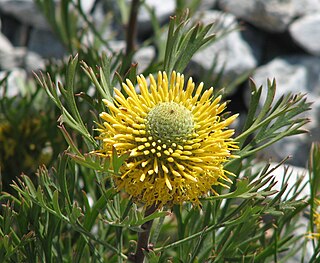
Isopogon anemonifolius, commonly known as broad-leaved drumsticks, is a shrub of the family Proteaceae that is native only to eastern New South Wales in Australia. It occurs naturally in woodland, open forest, and heathland on sandstone soils. I. anemonifolius usually ranges between one and two metres in height, and is generally smaller in exposed heathland. Its leaves are divided and narrow, though broader than those of the related Isopogon anethifolius, and have a purplish tinge during the cooler months. The yellow flowers appear during late spring or early summer and are displayed prominently. They are followed by round grey cones, which give the plant its common name drumsticks. The small hairy seeds are found in the old flower parts.
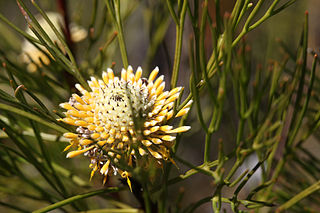
Isopogon anethifolius, commonly known as narrow-leaf drumsticks or narrow-leafed drumsticks, is a shrub in the family Proteaceae. The species is found only in coastal areas near Sydney in New South Wales, and to the immediate west. It occurs naturally in woodland, open forest and heathland on sandstone soils. An upright shrub, it can reach to 3 m (9.8 ft) in height, with terete leaves that are divided and narrow. The yellow flowers appear in the Spring, from September to December, and are prominently displayed. They are followed by round grey cones, which give the plant its common name of drumsticks. The small hairy seeds are found in the old flower parts.
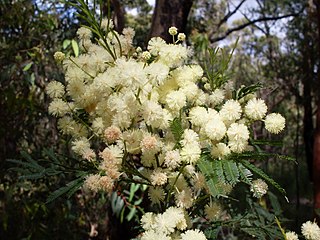
Acacia parramattensis, commonly known as Parramatta wattle, is a tree of the family Fabaceae native to the Blue Mountains and surrounding regions of New South Wales. It is a tall shrub or tree to about 15 m (49 ft) in height with phyllodes instead of true leaves. These are finely divided bipinnate. The yellow flowers appear over summer. It generally grows in woodland or dry sclerophyll forest on alluvial or shale-based soils, generally with some clay content.

Calectasia is a genus of about fifteen species of flowering plants in the family Dasypogonaceae and is endemic to south-western Australia. Plants is this genus are small, erect shrubs with branched stems covered by leaf sheaths. The flowers are star-shaped, lilac-blue to purple and arranged singly on the ends of short branchlets.

Angophora floribunda, commonly known as the rough-barked apple, is a common woodland and forest tree of the family Myrtaceae native to Eastern Australia. Reaching 30 m (100 ft) high, it is a large tree with fibrous bark and cream-white flowers that appear over the Austral summer. It grows on alluvial soils on floodplains and along watercourses. Much of the land it grew on has been cleared for agriculture.
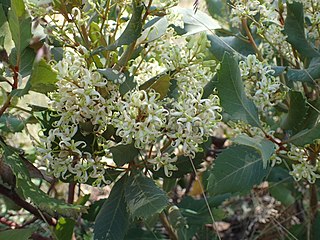
Lomatia fraseri, commonly known as tree lomatia, forest lomatia or silky lomatia is a plant of the family Proteaceae native to eastern Australia. It grows as a shrub or small tree, reaching 8–11 metres (26–36 ft) high, with highly variable leaves. The cream to white inflorescences appear over summer. It is found in rainforest margins, gullies and heathland in mountainous regions of Victoria and New South Wales. It regenerates from fire by regrowing from a lignotuber.

Acacia triptera, commonly known as spurwing wattle, is an erect or spreading shrub which is endemic to Australia.

Prostanthera phylicifolia, commonly known as spiked mint-bush, is a species of plant in the family Lamiaceae. It is an erect shrub with four-ridged branches, narrow egg-shaped to oval leaves and white or pale lilac-coloured flowers with purple and yellow spots.

Lomandra hystrix, commonly known as green mat-rush, or creek mat-rush, is a perennial, rhizomatous herb found throughout eastern Australia.

Persoonia terminalis, also known as the Torrington geebung, is a shrub belonging to the family Proteaceae, and native to northern New South Wales and southern Queensland in eastern Australia. Reported as a subspecies of Persoonia nutans in 1981, it was described as a species by Lawrie Johnson and his colleague Peter Weston in 1991.

Acacia oswaldii, commonly known as boree, umbrella wattle, umbrella bush, whyacka, middia, miljee, nelia and curly yarran, is a shrub or tree of the genus Acacia and the subgenus Plurinerves.

Lomandra effusa is a perennial, dioecious, rhizomatous herb native to Australia. It is a perennial tussock with bluish green, large, arching leaves which are distinctive by the two toothed leaf tip. It has white, cream or pink fragrant flowers during the months of June to October.
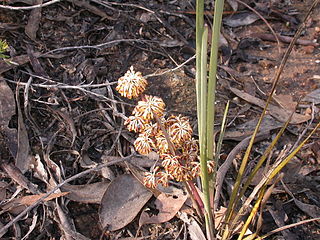
Lomandra multiflora, also commonly known as many-flowered mat rush, mat rush and many flowered mat-lily, is a perennial, rhizomatous herb found in Australia and Papua New Guinea. The mat rush is distributed widely in the region and common within its preferred growing conditions. Its conservation status is considered not to be of concern and risk.

Anthelepis is a genus of flowering plants belonging to the family Cyperaceae, and was first described in 2019 by the Australian botanists, Russell Barrett, Karen Wilson and Jeremy Bruhl.

Lomandra brevis is a species of plant in the Asparagaceae family, first described in 1962 by Alma Theodora Lee.

Lomandra cylindrica is a species of plant in the Asparagaceae family, first described in 1962 by Alma Theodora Lee.






















